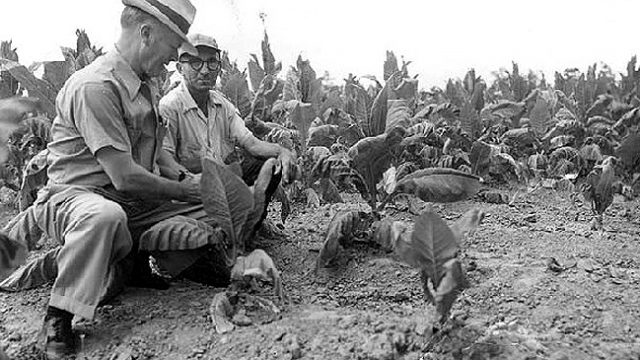Tobacco commission’s millions go up in smoke

WHEN TOBACCO WAS TOPS: Tobacco farmers inspect the crop in this 1953 photo taken in Halifax County.
By Kaitlyn Speer | Watchdog.org, Virginia Bureau
ALEXANDRIA, Va. — More than $5.2 million in “tobacco” grants to Virginia communities have disappeared, leaving some of the state’s most depressed areas deeper in the red.
From July 2007 until October 2014, 22 localities defaulted on Tobacco Region Opportunity Fund (TROF) grants or owe the Virginia Indemnification and Community Revitalization Commission money, said Ned Stephenson, the commission’s deputy director.
Fifteen of those localities owe a total of $5.2 million, according to documents obtained by Watchdog.org through a Freedom of Information Act request. Of the 22 localities that defaulted, 15 still owe money.
“I do not have or maintain a list,” Stephenson told Watchdog in an email. “We work these one at a time as they mature.”
Some of the poorest counties in Virginia owe the most. The city of Danville owes the commission $3.4 million, and the Lee County Industrial Development Authority (IDA) owes $600,000.
Lee County defaulted on two different grants, and the county’s IDA director acknowledged the probability of collecting a full reimbursement is quite low.
“The contracts are three-party contracts,” IDA Director Michael James said. “The commission administers the grant to us and we, then, administer the grant” to private companies that come to town with promises of jobs.
In the event of default, he said, the process works in reverse. The company owes the IDA and, in turn, the IDA owes the commission.
“We owe the commission regardless of whether we collect from the company,” James said.
Others owing money include Charlotte County, the town of Marion, Lunenburg County, the Patrick County Economic Development Authority, the Tazewell County IDA and the Washington County IDA. Each has received a notice of default and a demand for refund, or are subjected to a repayment agreement.
Virginia was given some $4.1 billion in reparations after 46 state attorneys general sued large tobacco companies in 1998. The tobacco commission received half that amount and, so far, has awarded 1,807 grants totaling more than $1 billion, according to its website.
The commission, as of August, had nearly $564 million in cash and investments.
To keep track of created jobs, the commission relies on Virginia Employment Commission data to verify companies are keeping their promises and creating jobs, according to Tim Pfohl, the commission’s interim executive director.
“That provides us an independently verified source that’s also used by the state for calculating business and income taxes,” he said in an email to Watchdog.
If a county defaults on a loan, the tobacco commission freezes any money going into that county. Stephenson said some localities have paid their debt while others are negotiating repayment plans, or have executed a repayment plan.
The Virginia Indemnification and Community Revitalization Commission, a 31-member body, was created in 1999 by the General Assembly to use the proceeds of the 1998 national tobacco settlement in the “promotion of economic growth and development in tobacco-dependent communities.”
Instead, some localities have gotten into deep financial trouble. Defaults have occurred when private companies fail to deliver promised jobs and capital investment within 36-months.
Though the commission has the number of private-sector jobs generated through the commission grants, it was not immediately available to Watchdog.
In 2011, the Joint Legislative Audit and Review Commission (JLARC) published a report recommending tighter accountability by the commission.
The commission’s “process for evaluating funding requests does not effectively screen out weak proposals,” the report states.
“The commission considers every application for funding, although this policy generates a significant workload that tends to discourage detailed review by the commission. Applications for funding often contain insufficient information, resulting in a widely varying quality and quantity of information.”
JLARC told Watchdog.org that as of September 2013, only nine of its 26 audit recommendations have been fully or partially implemented.
“Our review identified opportunities for the Tobacco Commission to use its limited funds more strategically and to slow the rate at which the commission withdraws funds from its endowment (the ‘burn rate’),” Drew Dickinson, a senior associate legislative analyst at JLARC, wrote in an email.
Pfohl, the commission’s interim executive director, said measures have been taken to protect the tobacco fund. The panel uses a formula to make sure an applicant aligns with economic factors like number of jobs, average wages and amount of investment.
The commission, locality and company also sign a three-party agreement to “capture the jobs and investment targets,” he said.
“Then we use Virginia Employment Commission jobs data and local Commissioner of Revenue data as a consistent, independent source of verification that the companies are meeting their targets,” Pfohl said.
But a free-market analyst says the program is fundamentally flawed.
“From the outset, it’s not going to work,” said Eileen Norcross, a senior research fellow at George Mason University’s Mercatus Center.
“These types of subsidies just don’t work. These programs demonstrate financial hazards and get local governments into debt. That’s not good public finance.”
-Kaitlyn Speer is a freelance writer for Watchdog.org, Virginia Bureau and can be reached at kspeer@watchdog.org or on twitter at @KSpeer11







